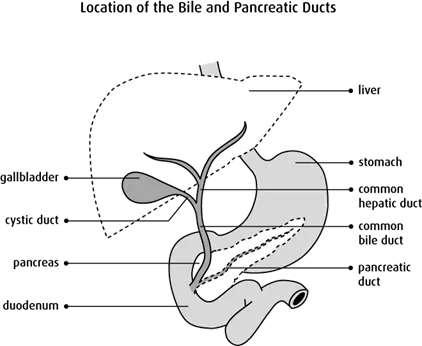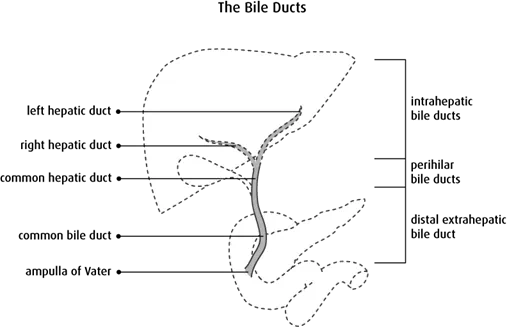The bile ducts
The liver, gallbladder and small intestine are connected by a series of thin tubes called bile ducts. The bile ducts are part of the digestive system. The bile ducts and gallbladder are also part of the biliary system, or biliary tract.

Structure
The common bile duct is a very thin tube, about 10–12.5 cm (4–5 inches) long. A series of ducts come together to form the common bile duct:
- Many very tiny tubes in the liver collect bile from the liver cells.
- These tiny tubes join to form small ducts. These small ducts then join to form larger ducts called the right and left hepatic ducts.
- The right and left hepatic ducts exit the liver and then join together to form the common hepatic duct.
- The common hepatic duct and the cystic duct join to form the common bile duct. The cystic duct connects the gallbladder (a small organ that stores bile) to the common bile duct.
- The common bile duct passes through the pancreas before it empties into the first part of the small intestine (duodenum). The lower part of the common bile duct joins the pancreatic duct to form a channel called the ampulla of Vater or it may enter the duodenum directly.
Intrahepatic bile ducts
The bile ducts within the liver are called intrahepatic bile ducts. These small ducts join together into larger ducts, ending in the left and right hepatic ducts. The right and left lobes of the liver are drained by these ducts. Information on intrahepatic bile duct cancer can be found in the liver cancer chapter.
Extrahepatic bile ducts
The extrahepatic bile ducts are outside the liver. The extrahepatic ducts include the part of the right and left hepatic ducts that are outside the liver, the common hepatic duct and the common bile duct. (The cystic duct is also outside the liver, but cancers of the cystic duct are grouped with gallbladder cancers.)
The extrahepatic bile ducts may be further divided based on their location:
Perihilar bile ducts
The hilum or hilar area is the area where the right and left hepatic ducts leave the liver and join to form the common hepatic duct. It also includes the point where the cystic duct joins the common hepatic duct. Because these ducts are close to the liver, they may be referred to as the proximal extrahepatic bile ducts.
Distal extrahepatic bile duct
This duct is formed by the common bile duct. It is farther away from the liver, between the junction where the cystic duct joins the common hepatic duct and the ampulla of Vater (but does not include these structures).

Function
The extrahepatic bile ducts are part of a network of ducts that carry bile from the liver and gallbladder to the small intestine. Bile is a yellowish-green fluid made by the liver. Bile flows from the liver, through the hepatic ducts, into the cystic duct and to the gallbladder, where it is stored.
Bile helps digest the fat in foods. Bile is mainly made up of:
- bile salts
- bile pigments (such as bilirubin)
- cholesterol
- water
If the bile is not needed for digestion, it flows into the cystic duct and then into the gallbladder, where it is stored. When bile is needed to digest food, the gallbladder contracts and releases bile into the cystic duct. The bile then flows into the common bile duct and is emptied into the small intestine, where it breaks down fats.
